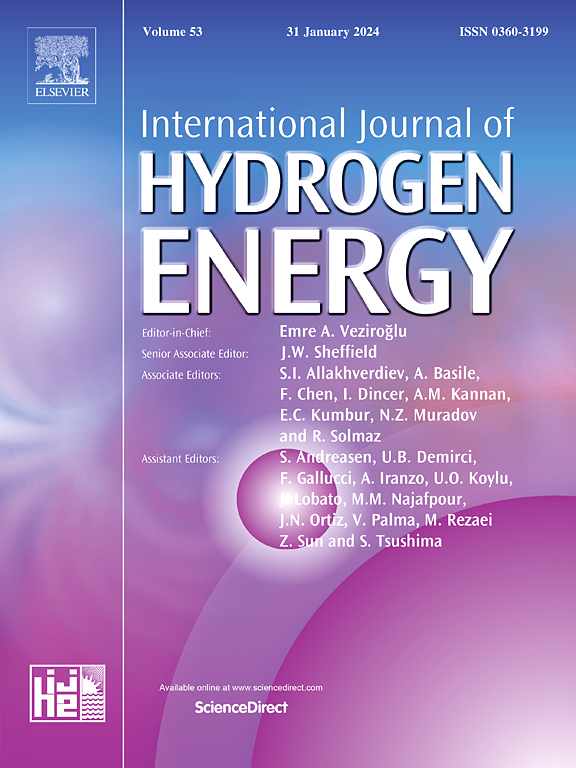Enhancing electrochemical hydrogen storage in nickel-based metal-organic frameworks (MOFs) through zinc and cobalt doping as bimetallic MOFs
IF 8.1
2区 工程技术
Q1 CHEMISTRY, PHYSICAL
引用次数: 0
Abstract
Pure nickel-based metal-organic frameworks (Ni-MOFs) represent highly promising materials for electrochemical applications, attributed to their cost-effectiveness, natural abundance, capacity to form Ni2⁺/Ni³⁺ redox couples, and exceptional catalytic activity. Nonetheless, their practical utility is limited by inherent challenges, including poor electrical conductivity, a propensity for stacking, and instability in aqueous environments, particularly under the demanding conditions of water-splitting reactions for hydrogen production. In this study, we aimed to address these limitations by designing and synthesizing enhanced porous Ni-terephthalic acid [Ni(TPA)] MOFs using a metal doping strategy. Zinc (Zn) and cobalt (Co) were selected as dopants due to their unique properties. Zn–Ni(TPA) and Co–Ni(TPA) MOFs were synthesized via a facile solvothermal method and subsequently compared with pure Ni(TPA). FE-SEM, XRD, EDS, FT-IR, and BET analyses were conducted to characterize the synthesized samples, confirming the formation of layered morphologies in Zn–Ni(TPA) and Co–Ni(TPA) with no detectable impurities. The electrical conductivities of the synthesized MOFs were evaluated using electrochemical impedance spectroscopy (EIS), and the corresponding Nyquist plots are presented. Moreover, the corrosion potential (Ecorr) analysis was conducted, revealing the superior anti-corrosion properties of the Co-Ni(TPA) MOF.
Electrochemical performance evaluations through cyclic voltammetry (CV) and chronopotentiometry (CP) revealed that the twentieth discharge capacity of Co–Ni(TPA) (4000 mAhg⁻1) significantly outperformed pure Ni(TPA) (1850 mAhg⁻1). Furthermore, the hydrogen storage capacities of pure Ni(TPA), Zn-doped Ni(TPA), and Co-doped Ni(TPA) were comparatively investigated to assess the impact of Zn and Co doping. The results revealed that Co–Ni(TPA) demonstrated a superior hydrogen storage capacity compared to Zn–Ni(TPA), likely due to the partial substitution of Ni2⁺ with Co2⁺, which increases the availability of free holes for gas adsorption.

纯镍基金属有机框架(Ni-MOFs)是极具电化学应用前景的材料,这归功于它们的成本效益、天然丰度、形成 Ni2⁺/Ni³⁺ 氧化还原偶的能力以及卓越的催化活性。然而,这些催化剂的实用性受到其固有挑战的限制,包括导电性差、易发生堆叠、在水环境中不稳定,尤其是在要求苛刻的水分离制氢反应条件下。在本研究中,我们采用金属掺杂策略设计并合成了增强型多孔对苯二甲酸镍[Ni(TPA)] MOFs,旨在解决这些局限性。由于锌(Zn)和钴(Co)的独特性质,我们选择它们作为掺杂剂。锌-Ni(TPA)和钴-Ni(TPA)MOFs 是通过简便的溶热法合成的,随后与纯 Ni(TPA)进行了比较。对合成样品进行了 FE-SEM、XRD、EDS、FT-IR 和 BET 分析,结果表明 Zn-Ni(TPA)和 Co-Ni(TPA)形成了层状形态,且未检测到杂质。利用电化学阻抗光谱(EIS)评估了合成 MOFs 的电导率,并给出了相应的奈奎斯特图。通过循环伏安法(CV)和时变电位计(CP)进行的电化学性能评估表明,Co-Ni(TPA) 的第二十次放电容量(4000 mAhg-1)明显优于纯 Ni(TPA)(1850 mAhg-1)。此外,还比较研究了纯 Ni(TPA)、掺杂 Zn 的 Ni(TPA)和掺杂 Co 的 Ni(TPA)的储氢容量,以评估掺杂 Zn 和 Co 的影响。结果表明,与 Zn-Ni(TPA)相比,Co-Ni(TPA)的储氢能力更强,这可能是由于 Co2⁺部分取代了 Ni2⁺,从而增加了气体吸附的自由孔。
本文章由计算机程序翻译,如有差异,请以英文原文为准。
求助全文
约1分钟内获得全文
求助全文
来源期刊

International Journal of Hydrogen Energy
工程技术-环境科学
CiteScore
13.50
自引率
25.00%
发文量
3502
审稿时长
60 days
期刊介绍:
The objective of the International Journal of Hydrogen Energy is to facilitate the exchange of new ideas, technological advancements, and research findings in the field of Hydrogen Energy among scientists and engineers worldwide. This journal showcases original research, both analytical and experimental, covering various aspects of Hydrogen Energy. These include production, storage, transmission, utilization, enabling technologies, environmental impact, economic considerations, and global perspectives on hydrogen and its carriers such as NH3, CH4, alcohols, etc.
The utilization aspect encompasses various methods such as thermochemical (combustion), photochemical, electrochemical (fuel cells), and nuclear conversion of hydrogen, hydrogen isotopes, and hydrogen carriers into thermal, mechanical, and electrical energies. The applications of these energies can be found in transportation (including aerospace), industrial, commercial, and residential sectors.
 求助内容:
求助内容: 应助结果提醒方式:
应助结果提醒方式:


